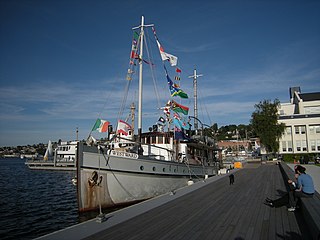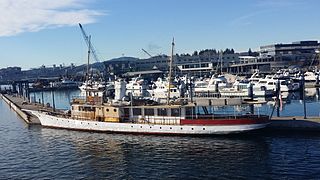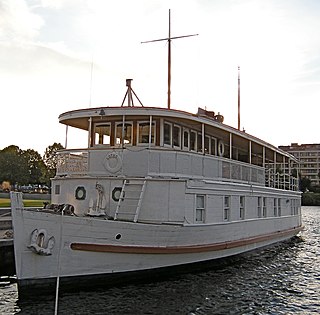
USS Amber (PYc-6) was a patrol boat in the United States Navy during World War II, built at Long Beach, California in 1930 as the yacht Infanta for the actor John Barrymore.

William Fife Jr., also known as William Fife III, was the third generation of a family of Scottish yacht designers and builders. In his time, William Fife designed around 600 yachts, including two contenders for the America's Cup. The Royal Yachting Association was formed in 1875 to standardise rules, and Fife and his rival G.L. Watson, were instrumental in these rule changes. Around one third of Fife's yachts still exist. His last designs were built in 1938.
L.E."Ted" Geary was a naval architect who grew up in Seattle, Washington. He designed and raced numerous competitive sailing vessels, and also designed commuter yachts, fishing boats, tug boats, and wooden-hulled freighters.

The history of steamboats on the Oregon Coast begins in the late 19th century. Before the development of modern road and rail networks, transportation on the coast of Oregon was largely water-borne. This article focuses on inland steamboats and similar craft operating in, from south to north on the coast: Rogue River, Coquille River, Coos Bay, Umpqua River, Siuslaw Bay, Yaquina Bay, Siletz River, and Tillamook Bay. The boats were all very small, nothing like the big sternwheelers and propeller boats that ran on the Columbia River or Puget Sound. There were many of them, however, and they came to be known as the "mosquito fleet."

The Coquille River starts in the Siskiyou National Forest and flows through the Coquille Valley on its way to the Pacific Ocean. Bandon, Oregon, sits at the mouth of the Coquille River on the Pacific Ocean. Before the era of railroads and later, automobiles, the steamboats on the Coquille River were the major mode of transportation from Bandon to Coquille and Myrtle Point in southern Coos County, Oregon, United States.

Lake Washington steamboats and ferries operated from about 1875 to 1951, transporting passengers, vehicles and freight across Lake Washington, a large lake to the east of Seattle, Washington. Before modern highways and bridges were built, the only means of crossing the lake, other than the traditional canoe or rowboat, was by steamboat, and, later, by ferry. While there was no easily navigable connection to Puget Sound, the Lake Washington Ship Canal now connects Lake Washington to Lake Union, and from there Puget Sound is reached by way of the Hiram M. Chittenden Locks.

For the passenger steamer that sank in 1901, see SS Islander

MV Westward is an 86-foot (26 m) motor yacht, "arguably Seattle’s most famous motor yacht," originally constructed in 1924 by Ted Geary for inventor Campbell Church, Sr., and currently owned by Bill Bailey. Her home port is Friday Harbor, Washington and she is listed on the U.S. National Register of Historic Places
J W Miller & Sons Ltd was a boatbuilder in St Monans, Fife, Scotland for over 200 years. They produced a variety of fishing boats, yachts and motor launches. The firm built 110 Fifie yachts and was known worldwide for the quality and craftsmanship of their vessels. The yard is now closed.

El Primero is a steam yacht that was built in 1893. This vessel was once considered one of the most luxurious yachts on the West Coast of the United States, and was one of the few steam yachts to be operated on Puget Sound. The yacht has since been converted to diesel, but it remained operational as of 2010.

Suquamish, built in 1914, was the first diesel-engined passenger vessel in the United States. Much later Suquamish was converted to a commercial fishing vessel and was registered as a Canadian vessel under the name Terry.

Joe D. Williamson was a sailor and a maritime photographer and historian who worked in the Puget Sound region.

Lotus is a motor yacht, launched in 1909 in Seattle, Washington. Lotus was employed as a pleasure vessel on Puget Sound, and in the waters of British Columbia and southeastern Alaska. Lotus was of a unique design and is now on the National Register of Historic Places.

Aquilo was a steam yacht which was built in Boston in 1901 for William Phelps Eno, a wealthy man who was the inventor of the stop sign. In 1910, Eno sold Aquilo and the yacht was brought to the west coast of North America, where it was operated principally in Puget Sound and coastal British Columbia. Aquilo had a long succession of wealthy owners. In 1966, the yacht caught fire and sank while en route from Seattle to Los Angeles.

Francis Charles Morgan-Giles was a boat designer and builder from Devon, England. He built rowing boats, dinghies, yachts and large motor cruisers. His boats were known for their high quality, elegance and craftsmanship.
The Geary 18 is an American sailboat that was designed by Ted Geary as a one-design racer and first built in 1926.

MV Malibu is a 100-foot (30 m) motor yacht built in 1926. She was designed by Ted Geary and built by N. J. Blanchard Boat Co., Seattle, Washington.
Madden, Lewis or Madden and Lewis Company or Madden and Lewis Corp. was a wooden shipbuilding company in Sausalito, California. To support the World War 2 demand for ships Madden, Lewis shipyard switched over to military construction and built: US Navy tugboats and Harbour Defence Motor Launch. The company was founded by James Herbert Madden Sr., who was also active in the Sausalito Yacht Club. James Herbert Madden Sr. and Gertrude Murphy Madden raised five children in Sausalito. Madden and Lewis Company also owned the Sausalito side of the Golden Gate Ferry Company that ran before the completion of the Golden Gate Bridge, the ferry was run by the Northwestern Pacific Railroad now the site of the Sausalito Ferry Terminal. After the war the yard returned to pleasure craft building and repair. On March 19, 1960 a large fire broke out at the boatyard. The boatyard was in Richardson Bay at 200 Johnson street, Sausalito, near the current Sausalito Yacht Harbor.
Lyle C. Hess (1912–2002) was an American naval architect, particularly known for his Aquarius and Balboa series of boats, built by Coastal Recreation.

Yarmouth Marina is a natural harbor and estuary of Casco Bay, and is located adjacent to the town of Yarmouth, Maine, United States. It is situated on the Royal River, around 0.5 miles (0.80 km) southeast of the town center, in an area known as Lower Falls. Today it functions solely as a marina.


















